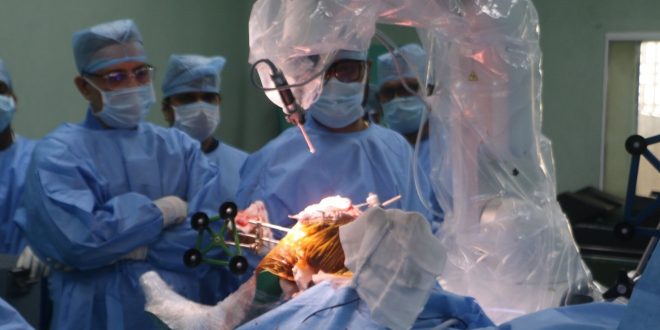Bhubaneswar: Robotic-assisted procedures in knee replacement surgery, presently being done at the Institute of Medical Sciences and SUM Hospital here, ensures greater precision, better results and can lead to shorter recovery time.
“A robotic knee replacement is similar to a traditional knee replacement when damaged tissues in the knee are removed and replaced with an artificial joint. The only difference is that it’s done with assistance from a robotic arm controlled by software and the surgeon,” Prof. (Dr.) Aniruddh Dash, Professor and Head of Department of Orthopaedics in the hospital, said.
In more complex cases, a robotic-assisted knee replacement offered a better balance in the soft tissues around the knee and better alignment of the joint, he said.
Describing it as the future of joint replacement surgery, Prof. Dash said it was being done in a medical college hospital in Odisha for the first time at IMS and SUM Hospital.
A patient, preparing for robotic-assisted knee replacement surgery would not have to prepare any differently than he would for a conventional surgery, he said.
Who can be the candidate for robotic knee replacement?
Prof. Dash said any person, who is a candidate for traditional knee replacement, is very likely a candidate for robotic-assisted knee replacement as well. Robotic knee replacements are ideal for patients having the most complex knee joint disease including those who have deformities in the femur after an injury, complex degeneration and hardware from previous surgeries, he said.
Detailing the advantages of robotic knee replacement surgery, he said it had the edge over traditional methods as it allowed enhanced surgical planning and greater precision.
Depending on the robotic option which was right for the patient, specialized 3-D images were taken in preparation for or during the surgery. These images helped the surgeon to accurately plan the optimal type and placement of the replacement joint to ensure the right size.
Robotic technologies also enhanced the surgeon’s expertise for more precise planning, tissue removal and implant placement. This could lead to faster recovery time, fewer complications and a lower likelihood of revision surgery, Prof. Dash said.
Stating that robotic-assisted knee replacement surgery was not done by a robot alone, he said it acted as a guide helping the surgeon to follow the plan laid out in advance.
“During traditional surgery, the surgeon is in control. However, he uses the robot as an additional surgical tool for best possible outcome,” he said adding robotic surgery enabled more precise incisions which helped achieve optimal positioning leading to better and faster recovery and longer life of the implant.
 Update Odisha-Latest Odisha News I Breaking News Get latest news on Odisha, Govt. Jobs, OSSC, OPSC, Entertainment, Crime, Sports, and Education
Update Odisha-Latest Odisha News I Breaking News Get latest news on Odisha, Govt. Jobs, OSSC, OPSC, Entertainment, Crime, Sports, and Education



